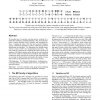Free Online Productivity Tools
i2Speak
i2Symbol
i2OCR
iTex2Img
iWeb2Print
iWeb2Shot
i2Type
iPdf2Split
iPdf2Merge
i2Bopomofo
i2Arabic
i2Style
i2Image
i2PDF
iLatex2Rtf
Sci2ools
VISUALIZATION
2003
IEEE
2003
IEEE
Counting Cases in Marching Cubes: Toward a Generic Algorithm for Producing Substitopes
We describe how to count the cases that arise in a family of visualization techniques, including Marching Cubes, Sweeping Simplices, Contour Meshing, Interval Volumes, and Separating Surfaces. Counting the cases is the first step toward developing a generic visualization algorithm to produce substitopes (geometric substitutions of polytopes). We demonstrate the method using a software system (“GAP”) for computational group theory. The case-counts are organized into a table that provides a taxonomy of members of the family; numbers in the table are derived from actual lists of cases, which are computed by our methods. The calculation confirms previously reported case-counts for large dimensions that are too large to check by hand, and predicts the number of cases that will arise in algorithms that have not yet been invented. CR Categories: G.2 [Discrete Mathematics]: Combinatorics— Counting problems; G.4 [Mathematical Software]: Algorithm Design and Analysis;
Computational Group Theory | Generic Visualization Algorithm | Visualization | VISUALIZATION 2003 | first Step |
| Added | 05 Jul 2010 |
| Updated | 05 Jul 2010 |
| Type | Conference |
| Year | 2003 |
| Where | VISUALIZATION |
| Authors | David C. Banks, Stephen A. Linton |
Comments (0)

